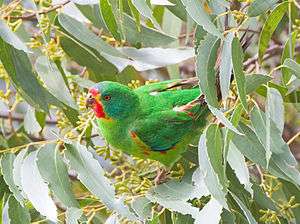Warby–Chiltern Box–Ironbark Region

The Warby–Chiltern Box–Ironbark Region comprises a cluster of separate blocks of remnant box-ironbark forest habitat, with a collective area of 253 km2, in north eastern Victoria, south-eastern Australia.
Description
This site lies to the east of the Rushworth Box-Ironbark Region IBA. It includes the Reef Hills and Warby Range State Parks, the Boweya Flore and Fauna Reserve, Rutherglen Conservation Reserve, Mount Lady Franklin Reserve and part of Chiltern-Mount Pilot National Park. Most of it lies within protected areas or state forests, encompassing only small blocks of private land.[1]
Birds
The site has been identified as an Important Bird Area (IBA) by BirdLife International because it provides feeding habitat for relatively large numbers of non-breeding swift parrots when flowering conditions are suitable, as well as the last few endangered regent honeyeaters in Victoria. It also supports small numbers of painted honeyeaters, diamond firetails and non-breeding flame robins.[2] Declining woodland birds still present in the IBA include brown treecreepers, speckled warblers, hooded robins, grey-crowned babblers, Gilbert's whistler and, occasionally, migrant black honeyeaters. crested bellbirds are locally extinct.[1]
References
- 1 2 BirdLife International. (2011). Important Bird Areas factsheet: Warby-Chiltern Box-Ironbark Region. Downloaded from http://www.birdlife.org on 2011-11-20.
- ↑ "IBA: Warby-Chiltern Box-Ironbark Region". Birdata. Birds Australia. Retrieved 2011-11-20.
Coordinates: 36°18′40″S 146°14′01″E / 36.31111°S 146.23361°E